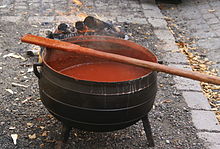| Falu red | |
|---|---|
 A traditional Finnish falu red log house in Äänekoski, Central Finland A traditional Finnish falu red log house in Äänekoski, Central Finland | |
| Hex triplet | #801818 |
| sRGB (r, g, b) | (128, 24, 24) |
| HSV (h, s, v) | (0°, 81%, 50%) |
| CIELChuv (L, C, h) | (28, 75, 12°) |
| Source | ColorHexa |
| B: Normalized to (byte) | |
Falu red or falun red (/ˈfɑːluː/ FAH-loo; Swedish: falu rödfärg, pronounced [ˈfɑ̂ːlɵ ˈrø̂ː(d)færj]) is a permeable red paint commonly used on wooden cottages and barns in Sweden, Finland, and Norway.
History
Following hundreds of years of mining copper in Falun, large piles of residual product were deposited above ground in the vicinity of the mines.
By the 16th Century, mineralization of the mine's tailings and slag added by smelters began to produce a red-coloured sludge rich in copper, limonite, silicic acid, and zinc. When the sludge was heated for a few hours and then mixed with linseed oil and rye flour, it was found to form an excellent anti-weathering paint. During the 17th century, falu red began to be daubed onto wooden buildings to mimic the red-brick façades built by the upper classes.
In Sweden's built-up areas, wooden buildings were often painted with falu red until the early 19th century, until authorities began to oppose use of the paint.
Resurgence
Falu red saw a resurgence in popularity in the Swedish countryside during the 19th century, when poorer farmers and crofters began to paint their houses. Falu red is still widely used in the countryside. The Finnish expression punainen tupa ja perunamaa, "a red cottage and a potato patch", referring to idyllic home and life, is a direct allusion to a country house painted in falu red.

Composition
The paint consists of water, rye flour, linseed oil, silicates, iron oxides, copper compounds, and zinc. As falu red ages the binder deteriorates, leaving the color granules loose, but restoration is easy since simply brushing the surface is sufficient before repainting.
The actual color may be different depending on the degree to which the oxide is burnt, ranging from almost black to a bright, light red. Different tones of red have been popular at different times.
References
- "Falu red / #801818 hex color". ColorHexa. Archived from the original on 26 May 2022. Retrieved 2 May 2022.
- "Sweden's most tried and tested house paint". Archived from the original on 22 March 2016. Retrieved 11 May 2013.
- "Falu rödfärg Original – Falu Rödfärg". Falu Rödfärg (in Swedish). Archived from the original on 17 March 2018. Retrieved 17 March 2018.